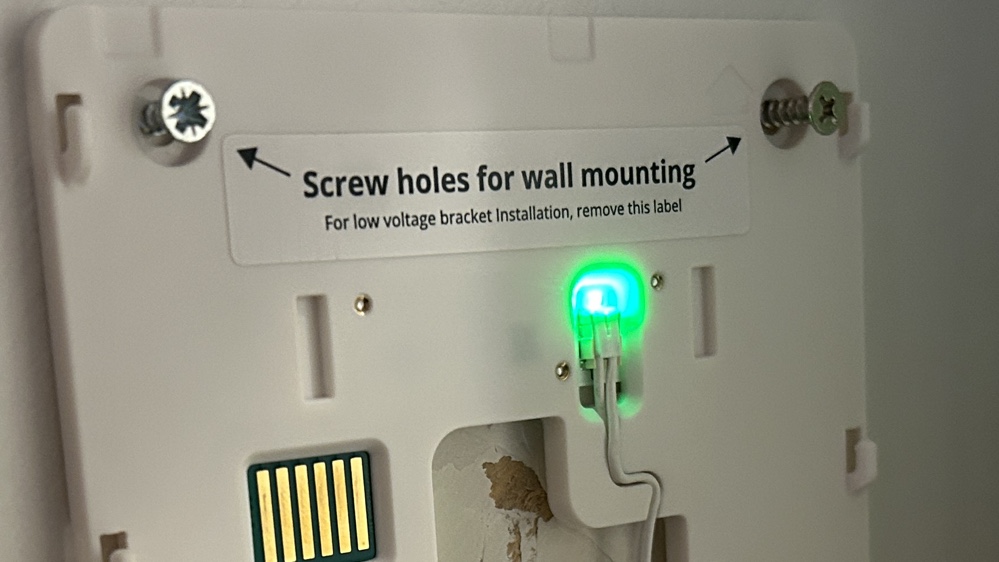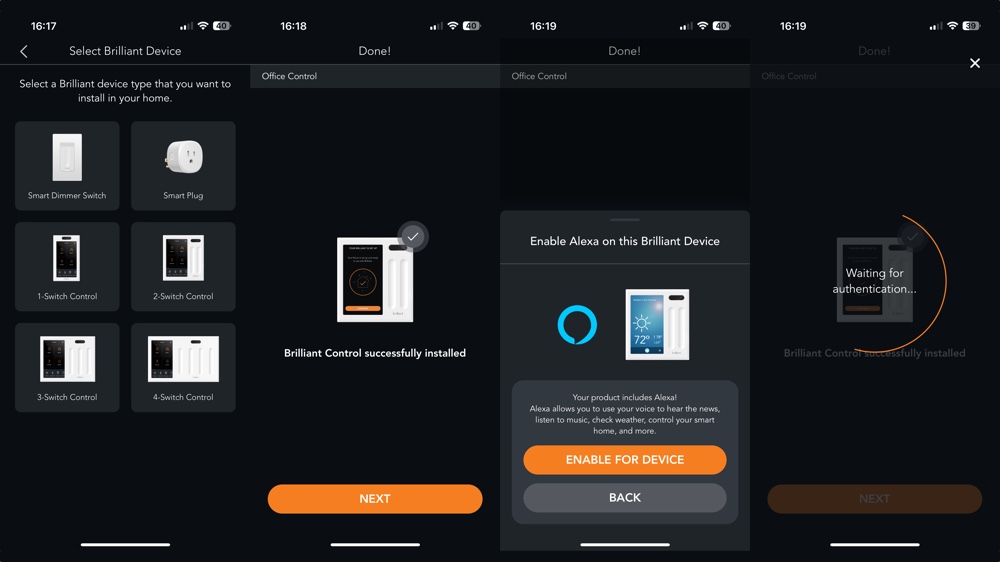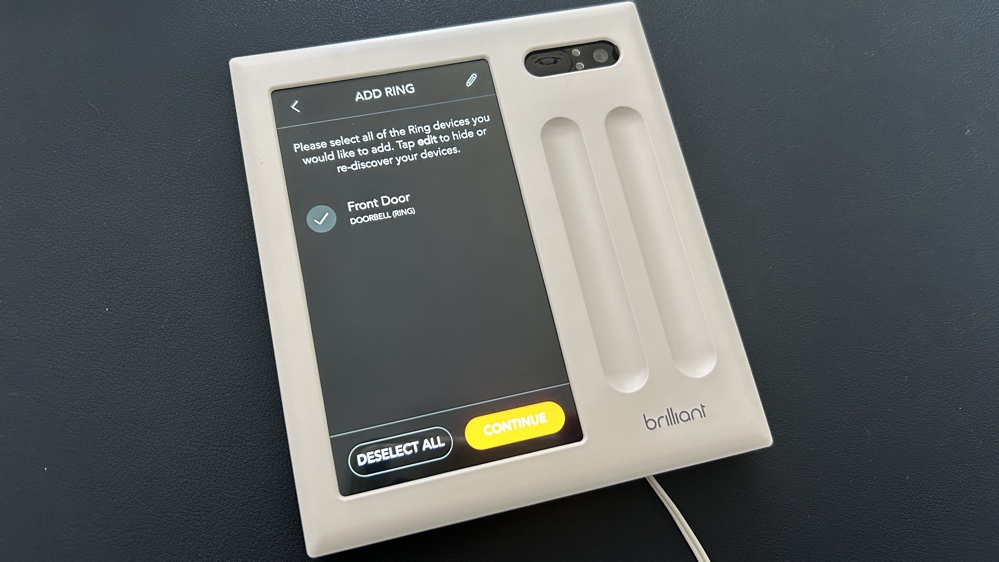
The Brilliant Plug-In Panel Home Control wants to be the front and center of your smart home and, if it had Zigbee, Z-Wave or Thread on board, and a few more integrations then it probably could be. However, despite the device being super simple to install and use, and for the performance and everyday use to be great, it does fall down a little bit by its limitations, especially given it’s pricey too (albeit with a nice price-cut at present). If you’re a heavy Hue and Sonos user (and you use a Ring doorbell) then it may well be the perfect room companion for you though.
-
Super simple installtion -
Nice crisp display -
Built-in motion sensor -
Works with loads of brands
-
Alexa performance is patchy -
Cloud based, sometimes laggy -
No Zigbee, Thread or Matter -
Sound is terrible
Brilliant Plug-In Panel Home Control: Introduction
- Connectivity: Wi-Fi 2.4GHz
- Ecosystems: Amazon Alexa, Apple HomeKit, SmartThings, Google Home
- Voice Assistant: Amazon Alexa


When we first reviewed the Brilliant Smart Home Control back in 2019 we lamented the fiddly installation process and the fact you were limited to placing it wherever you currently had dumb light switches in place, with a neutral wire present.
Those quibbles have, seemingly, now been solved with the launch of Brilliant Plug-In Panel Home Control that, as you may have guessed from the name, simply plugs in to your existing plug sockets. The idea is you can then place it anywhere, on any wall, that you like.
With integrations with many of the big smart home players, such as Hue, Sonos, Ring, Ecobee, SmartThings, Kwikset and more, and with Alexa built-in, the Brilliant Plug-In Panel Home Control goes up against the likes of the Amazon Echo Hub and the Rithum Switch vying for some of your wall space.
With a $449 price tag it’a actually much more expensive than those rivals but the good news is that Brilliant seems to have slashed the price to sub-$300 and I hope that’s a permanent change as it’s much more reflective of its value.
I’ve had it stuck on my wall for a few weeks now, so read on for my full Brilliant Plug-In Panel Home Control to find out more.
Design and installation
- Slim form factor and wall-mountable
- Touchscreen and capacitive slider controls
- Plugs into regular plug socket


Apart from the power option, the Brilliant Plug-In Panel Home Control is essentially the exact same premise as the existing Brilliant Smart Home Control devices – although it does only come (at the moment, anyway) with a dual touch-capacitive slider setup; the light-switch versions also come in 3 and 4 slider options, or with no slider at all.
These sliders give you physical control over things like light dimming, speaker volume, or adjusting your smart blinds; they work just like the grooves on the latest Sonos speakers in that they don’t just have slide up and down controls for adjustments, but you can also set tap and double-tap gestures too – so handy for things like dimming lights but also turning them on and off easily.
Just like its older stablemates, it has a 5-inch, 720p HD, LCD touch screen that also offers control options as well as great visuals such as photo slideshows and live views of security cameras and video doorbells.


The screen is pretty great for a small form factor devices, with a nice matte effect.
Also on board is a built-in microphone, speaker and a camera lens (with a physical shutter), as well as motion, ambient light and temperature sensors.


My first impressions was that it’s quite big. Don’t be fooled into thinking it’s a like-for-like light switch replacement; measuring in at 135 x 121mm, it’s a sizeable square-ish device that you’ll be adding to your wall.
Talking of which, in the box you’ll find everything that you need in order to get the Brilliant mounted your wall, including the screws and their correctly sized wall anchors.


The power cable clips into the unit’s wall mount; it’s tiny and incredibly fiddly but you’ll know when you’ve got it in correctly thanks to a satisfying click when it pops in. The other end of the wire terminates with a regular USB port – Brilliant gives you a USB plug to use in the box, but any one that you have laying around will do the job.
You have two options when choosing how to feed the wire, depending on whether you are able to hide it or not.
For most people, you will probably need to have a wire on show, from the device to the plug socket where it’s powered up from.
But if you can get rear access to hide the power cable and plug, say in a cupboard behind a wall, then you have the option to feed the cable outwards too.
The initial boot up sequence is pretty slow, it takes around 20 seconds before the Brilliant logo shows up on the screen, but you can be sure your wire is correctly in place thanks to a reassuring green LED that lights up on the back of the unit when it’s receiving power.


The Brilliant Smart Home System app syncs up to your device using a QR code and takes you through the setup options.
It will ask you if you want your Brilliant Control to work with Alexa, Google Home or HomeKit.


I chose Amazon Alexa and was then was greeted with a spinning ‘Waiting for Authentication’ wheel of death.
When I clicked the cross at the top it told me that my Amazon account couldn’t be authenticated but it never gave me option.


I ignored this for the initial setup in the end, and waited to authorize my Amazon account on the device directly.
Don’t be fooled by those Google Home or HomeKit options though; there’s no Siri or Google Assistant voice capabilities on the Brilliant device itself; rather devices added to the Brilliant can then be accessed within those smart home systems.
The device will attempt to scan your network and find compatible devices to add. Sonos was discovered on its own but it then added them to rooms in a bit of a clunky way and required a bit of tidying up.


Hue bulbs are added in the normal push-Bridge-button way and the likes of Ring, Nest and SmartThings are done via account linking in the cloud, but more on that in a bit…
Features
- Alexa built-in
- Sensors built in for automations
- Multiple brands compatible
- Scenes and routines configurable
Unlike the smart light switch version of Brilliant, you won’t get physical controls over dumb light switches (as it doesn’t touch your light circuit wiring at all) but it can be used to control smart lights from a wide range of brands including the likes of Philips Hue, Lutron, Lifx and WeMo.
It’s not just lights though, the 5-inch LCD touchscreen also gives you physical controls over a wide range of smart home tech including Sonos speakers, SmartThings devices, smart security systems, smart thermostats, video doorbells and whole lot more (see here for everything Brilliant works with).
There are a number of big names that work with Brilliant straight out of the box (sort of, some require accounts to be synced first) – think Sonos, Philips Hue, Ecobee, Lutron, Kwikset, Schlage, Yale, TP-Link, Yale, WeMo, Resideo, Ring and more – and it’s also possible to add in non-compatible brands using SmartThings, as it can pull in devices direct from your SmartThings system too.
Once you’ve got everything synced-up you can then configure how the Brilliant Plug-In Panel will control these devices.
You get four shortcut icons on the homepage, which are great for initiating scenes and starting routines. Think having your blinds shut, the lights dim and your smart TV power on for some movie action; or having a door unlock and a security system disarm when someone you know comes calling.
Once you configure these shortcuts, either on the app or via the device itself, you are able to go back in and change them anytime you like.
Below these you’ll find a row of icons that give you access to menus to control any other devices you have synced, including the likes of doorbells, cameras, locks, lights, blinds, sprinklers and speakers anywhere in the house.
So, while it makes sense to have localized shortcuts specific to the area of the house the Panel is mounted, and have those touch-capacitive sliders set to control devices in the same room such as lights, you can actually access and control devices around the whole house.
Standout performers, in terms of compatibility, for me were Hue, Sonos and Ring.
When syncing your Philips Hue system it helpfully it lets you choose what lights and zones to bring over, you don’t need to sync them all. However, you then have to do room by room configuration of where these bulbs live in the Brilliant system, which seems silly.
Also, I couldn’t get rid of an alert that I hadn’t added all my lights, which appeared on the top of the touchscreen for a few days.
Those quibbles aside though and the Brilliant is a great way to control Hue lights and add them to automations that are easily triggered with the shortcuts.


Sonos plays nicely on the Brilliant, with lots of options like grouping speakers, playlists, last played and so on, with easy to use controls and album artwork looking great on the screen. It’s actually a much better Sonos experience than I have come across with super high end systems such as Control 4.
Ring syncing is not native through Alexa, you have to sync up via an email link, which is a bit clunky but once you’ve done it, you’ll get doorbell alerts, live view and two-way talk.


If you have a compatible smart lock, you could even unlock the door via the Brilliant Panel (or indeed the app) when you’ve answered the front door.
I also tested Nest and SmartThings on the Brilliant but wasn’t so impressed. The lag and wait times for everything was a lot more noticeable than for Hue, Sonos and Ring.
Alexa is also a bit hit and miss. Once you’ve synced up your Alexa account, Amazon’s voice assistant will work just as it does in any native Echo smart speaker – you can control all of your synced smart home devices in exactly the same way you already do, no extra steps are needed.
Brilliant will, however, direct you to enable its Alexa skill to control lights and so on. However, this is more useful on the light-switch models as it will allow you to control dumb lights that are wired to them, so I’d avoid the skill on the Plug-In model.
The speaker is pretty flat and tinny, with sound quality much worse than that of an Echo Dot or even Echo Pop; it actually reminds me of the old Echo Flex.
The microphones are nowhere near as good at picking up voice commands as an Echo speaker, so my advice would be to consider the Alexa capabilities a ‘bonus’ rather than a key feature.
By default the Brilliant will scroll through some same-same wallpaper images on the display but you can upload your own photos (a maximum of 50) through the app for a more personal experience.
The ambient sensor can be used to have the brightness of the display adapt to its surroundings and you can also have the time displayed too, although the time-zones on offer are US-only as that’s the only region the Plug-In is officially available.


The built-in motion sensor allows you to create motion zones and use the Brilliant itself as a trigger for routines. For example, you could have specific lights turn on when motion is detected at certain times of the day, or have your favorite radio station begin if you enter the room in the morning.
On the device there are some nice motion threshold settings too, so you can get the exact level of motion you’d want to trigger a routine.
You can also use the camera as a security camera, using the app to get a live view of your house.


Connectivity and performance
Brilliant itself is a platform smart home platform, sort of. But everything it does is cloud based. Unlike Amazon’s Echo Hub, for example, there’s no radio connectivity apart from Wi-Fi, so you can’t natively add Zigbee or Thread devices, although you can using the likes of Alexa or SmartThiungs.
The Plug-In model can communicate with the traditional Brilliant switches over a Bluetooth mesh (including intercom capabilities) and form part of a Brilliant whole-home smart system.
However, those touchscreen switches start at $400 and the dimmers at $70, so it’d be a pricey smart home system to get up and running.
I mention that it’s only Wi-Fi and that means that any commands and controls that the Brilliant Panel sends to your devices is done over the cloud.
For things like starting a Sonos playlist or getting an alert when someone rings the doorbell, then that’s not really something you’d notice.
However, when adjusting lights, cloud actions are never going to be as zippy as Zigbee, so you may notice your Hue bulbs are a tad slower to react.
Overall though, the lag isn’t really a problem although I did notice significant delays with both Nest and SmartThings devices, as mentioned.
In late 2022 Brilliant announced plans to join the Connectivity Standards Alliance, but there’s no sign yet of its Panels or devices becoming Matter smart home compatible just yet.
Final thoughts
The Brilliant Plug-In Panel Home Control is a great, albeit quite expensive and somewhat limited, device that gives you great physical controls over a range of well-known smart home brands.
It’s a shame it doesn’t have the connectivity on board to really make it a genuine smart home hub but what it does do, it does well.
How we test
When we publish our reviews, you can rest assured that they are the result of “living with” long term tests.
Smart home hubs and bridges play a key part in controlling, a smart home ecosystem, or a range of products that – supposedly – all work in harmony.
Because we’re testing smart home kit all day, everyday, we know what matters and how a particular smart controller compares to alternatives that you might also be considering.
Our reviews are comprehensive, objective and fair and, of course, we are never paid directly to review a device.
Read our guide to how we test smart home hubs to learn more.
FAQs
No, unlike other Brilliant control options, this Panel boasts a plug-and-play design. It simply needs a standard outlet for power, making installation a breeze.
The Brilliant Panel has Amazon Alexa built-in, so you can control your lights, thermostats, and other compatible devices with just your voice.
No Matter, no Thread, no Zigbee.






